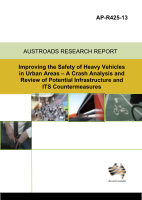Freight

- Publication no: AP-R425-13
- ISBN: 978-1-921991-75-2
- Published: 11 March 2013
- PDF (free) Download
Heavy vehicle freight transport in Australia is expected to double by 2020, as compared to 2000 levels. In New Zealand, similar growth in heavy vehicle transport is anticipated. The greatest impact from this growth will occur around urban areas where facilities such as ports, inter-modal freight terminals, large warehouses and distribution centres are located and accessed.
The projected increase has significant implications for heavy vehicle road safety, particularly in urban areas where heavy vehicles will be required to share an increasingly constrained and congested road network with other road users. While the reported trend for crashes involving heavy vehicles indicates an overall continuing reduction, the number of crashes that involve a heavy vehicle, and the fatalities and injuries resulting from them, remain an important issue to address for the transport industry and road agencies in Australia and New Zealand.
Through a review of literature and analysis of crash data at intersection and mid-block locations, this report outlines the primary contributing factors in heavy vehicle crashes on urban roads.
Also discussed are treatments that could be considered by Australian and New Zealand agencies to address the identified safety deficiencies. The suitability and effectiveness of intelligent transport system (ITS) based treatments is explored and three countermeasures are nominated for consideration by Austroads as future trials to determine the effect these countermeasures may have on heavy vehicle safety.
- 1. Introduction
- 1.1. Background
- 1.2. Objectives
- 1.3. Stage 1 Tasks
- 1.3.1. Schedule 1
- 1.3.2. Schedules 2 and 3
- 1.4. Structure of Report
- 2. Method
- 2.1. Introduction
- 2.2. Identification of Site Inspection Locations
- 2.3. Crash Analysis
- 2.4. Site Inspections
- 2.5. Potential Treatments
- 2.6. Workshop
- 3. Identification of site inspection locations
- 3.1. Introduction
- 3.2. Selection Analysis
- 4. Crash Analysis
- 4.1. Introduction
- 4.2. Scope and Limitations of the Crash Data Analysis and Site Selection
- 4.3. Crash Characteristics
- 4.3.1. Vehicle Manoeuvres
- 4.3.2. Vehicle Types
- 4.4. Time-of-day Characteristics
- 4.5. Contribution of Light and Weather Conditions
- 4.5.1. Light Conditions
- 4.5.2. Weather Conditions
- 4.6. Site Characteristics
- 4.6.1. Speed Limit
- 4.6.2. Alignment
- 4.6.3. Type of Traffic Control
- 4.7. Observations from Crash Analysis
- 5. Site investigations
- 5.1. Introduction
- 5.2. Features Investigated
- 5.3. Indications from Site Inspections
- 5.3.1. Frequency of Possible Contributing Crash Factors
- 5.3.2. Intersections
- 5.3.3. Mid-block Locations
- 5.4. Summary of Contributing Site Crash Factors
- 6. Potential countermeasures
- 6.1. Introduction
- 6.2. Consideration of Crash Analysis and Potential Contributing Factors
- 6.2.1. Intersections
- 6.2.2. Mid-block Locations
- 6.3. Identification of Potential Countermeasures
- 6.4. Review of Countermeasures
- 6.4.1. Potential Conventional Countermeasures
- 6.4.2. Potential ITS Countermeasures
- 7. Workshop
- 7.1. Purpose of the Workshop
- 7.2. Tables and Data Management
- 7.2.1. Site Investigation
- 7.2.2. Issues and Treatments
- 7.2.3. Treatments/Sites Table
- 7.3. Workshop Presentations
- 7.4. Workshop Feedback and Discussion
- 7.5. Workshop Conclusions
- 8. ITS project nominations for improving heavy vehicle safety in urban areas
- 8.1. ITS Project Nomination Criteria
- 8.2. Trial ITS Projects
- 9. Conclusions
- References
- Appendix A 2003–2007 crash data analysis
- A.1 Severity of Casualty Crashes
- A.2 Casualty Crashes by Year (2003–2007)
- Appendix B Site investigations
- B.1 Site Investigation Locations
- B.2 Standard Inspection Sheet
- Appendix C Crash data
- C.1 DCA Coding Used in NSW
- C.2 Crash Patterns at Intersection and Mid-block Locations
- Appendix D Contributing and potential crash factors
- D.1 Summary of Contributing Factors at Inspected Sites
- Appendix E Treatments and sites
- E.1 New South Wales
- E.2 Victoria
- E.3 Queensland
- E.4 Western Australia
- Appendix F workshop presentation
- Appendix G workshop feedback
- Appendix H Research project methods
- H.1 Safety Enhanced Driver Systems – A Combination of Fixed and Active/Real-time Inputs/Alerts to Drivers
- H.2 Dilemma Zone – Activated Traffic Signal Clearance Time Extension
- H.3 Advance Rest Area Availability/Advice
